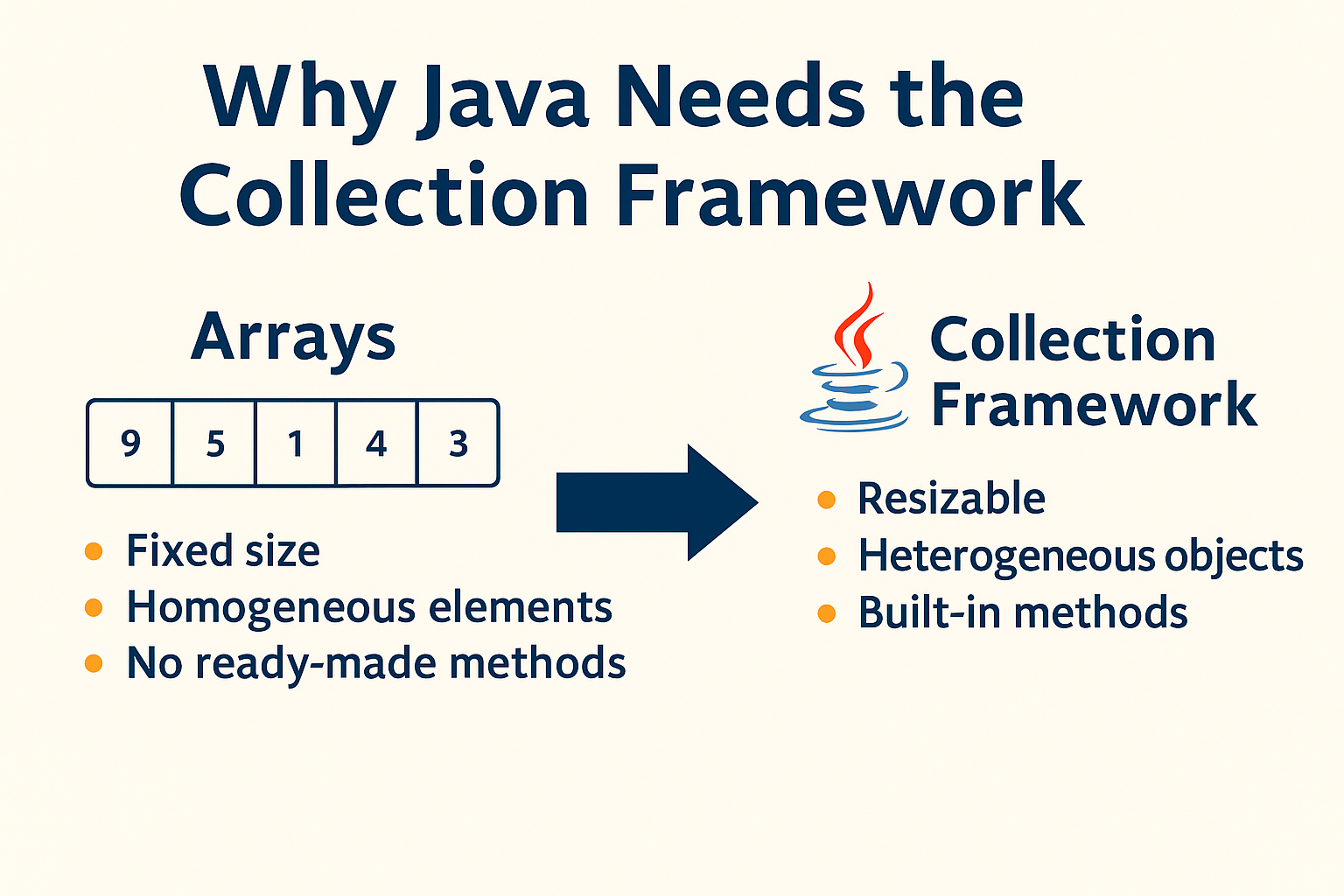“Code is read more often than it is written.” – Guido van Rossum
In early Java (pre‑1.2), arrays were the only way to store multiple objects under a single variable. While arrays are fast and simple, they become pain points as soon as requirements evolve beyond “store a few fixed elements.” This article explores exactly why arrays fall short and how the Java Collection Framework (JCF) revolutionized data handling.
🗓️ 1. A Brief History
| Year | Milestone |
|---|---|
| 1995 | Java 1.0 ships – arrays are primary container. |
| 1998 | Java 1.2 introduces the Collection Framework (ArrayList, HashMap, etc.). |
| 2004 | Java 5.0 adds Generics – type‑safe collections (List<String>). |
| 2011 | Java 7 adds the diamond operator (<>) and ConcurrentSkipListMap. |
| 2014+ | Lambdas & Streams make collections functional (list.stream()). |
Understanding this evolution helps you appreciate why modern Java rarely uses raw arrays outside of performance‑critical or low‑level code.
🚧 2. Core Limitations of Arrays
2.1 Fixed Size
int[] bigData = new int[1_000_000]; // allocate 1M slots
- Wasted Memory: If you store 3 integers, 999 997 slots remain empty.
- Insufficient Capacity: If you need 1 001 000 integers, you must allocate a new larger array and copy everything over.
2.2 Homogeneous Elements
Employee[] staff = new Employee[50]; // only Employee objects
Need to mix Employee and Contractor? Not allowed.
2.3 No Built‑In Algorithms
Tasks like binary search, sorting, or deduplication require manual, error‑prone code:
// Insertion sort on array (boilerplate)
for (int i = 1; i < arr.length; i++) {
int key = arr[i];
int j = i - 1;
while (j >= 0 && arr[j] > key) {
arr[j + 1] = arr[j];
j--;
}
arr[j + 1] = key;
}
2.4 No Thread‑Safe Variants
Arrays provide no out‑of‑the‑box concurrency control such as synchronized collections or lock‑free structures.
🧬 3. Enter the Collection Framework
The JCF groups containers by behavior rather than by underlying implementation.
| Interface | Typical Implementations | Key Property |
|---|---|---|
List |
ArrayList, LinkedList, Vector |
Ordered & indexed |
Set |
HashSet, LinkedHashSet, TreeSet |
No duplicates |
Queue |
ArrayDeque, PriorityQueue, LinkedList |
FIFO/LIFO/Priority |
Map |
HashMap, LinkedHashMap, TreeMap, ConcurrentHashMap |
Key‑value pairs |
The framework also provides:
- Algorithms (
Collections.sort,Collections.shuffle,Collections.binarySearch) - Wrappers (
Collections.synchronizedList,Collections.unmodifiableSet) - Concurrent collections (
CopyOnWriteArrayList,ConcurrentLinkedQueue)
3.1 Dynamic Sizing Example
List<Integer> numbers = new ArrayList<>();
for (int i = 0; i < 1_000_000; i++) {
numbers.add(i); // grows automatically
}
3.2 Heterogeneous Storage
List<Object> mixed = new ArrayList<>();
mixed.add(new Employee());
mixed.add("Notes");
mixed.add(LocalDate.now());
Tip: Use generics for type‑safety (
List<Employee>), but heterogeneous storage is possible.
🔍 4. Deep Dive: Standard Data Structures
| Data Structure | Collection Implementation | Complexity (Big‑O) |
|---|---|---|
| Dynamic Array | ArrayList |
add O(1)*, get O(1) |
| Doubly Linked List | LinkedList |
addFirst O(1) |
| Hash Table | HashMap, HashSet |
put/get O(1)* |
| Balanced Tree | TreeMap, TreeSet |
put/get O(log n) |
| Skip List | ConcurrentSkipListMap |
put/get O(log n) |
* Amortized; may degrade under edge cases (hash collisions, array resize).
🛠️ 5. Arrays vs Collections – Code Comparison
Adding 1M ints & Sorting
| Arrays | Collections |
|---|---|
| Allocate large array manually. | List<Integer> list = new ArrayList<>(); |
| Write loop to copy when full. | list.add(value); auto‑grows |
Manual Arrays.sort(arr); |
Collections.sort(list); |
Collections reduce boilerplate, lower bug risk, and improve readability.
💡 6. When Not to Use Collections
- Primitive Bulk Operations
Rawint[]is still faster and memory‑efficient for tight numeric loops. - Fixed‑size Buffers / Images
Pixel grids or circular buffers with known length. - JNI Interop
Native methods often expect primitive arrays.
Use arrays for performance‑critical, fixed‑size structures; otherwise choose a Collection.
🎓 7. Interview Corner
| Question | Good Answer Highlights |
|---|---|
Why choose ArrayList over LinkedList? |
Faster random access (O(1) vs O(n)). |
How does resizing work in ArrayList? |
Creates a new array (usually 1.5x size) and copies elements. |
How does HashSet prevent duplicates? |
Uses hashCode() + equals() under the hood. |
Prepare these nuances to impress interviewers.
🚀 8. Best Practices
- Favor Interfaces (
List,Set) over concrete types (ArrayList). - Leverage Generics to avoid
ClassCastException. - Use Streams for Declarative Processing:
long count = list.stream() .filter(e -> e.getAge() > 30) .count(); - Choose the Right Collection based on Big‑O requirements.
🏁 Conclusion
Arrays laid the groundwork for storing groups of values, but their rigidity quickly becomes a liability in real applications. The Java Collection Framework delivers dynamic sizing, powerful algorithms, and rich data structures out‑of‑the‑box, making Java development faster, safer, and more expressive.
